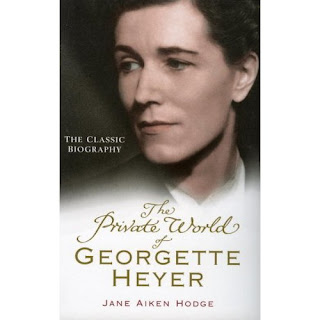This week we start our discussion of Georgette Heyer’s Venetia, led by Carolyn. I’ve already read the first seven chapters and then some.

Georgette Heyer, 1902-1974, is credited with creating the Regency Romance, even now the most popular historical romance genre. Heyer’s first book came about when she was 19. She created The Black Moth, a Georgian story, as a way to entertain an ill brother. It was the start of a wonderful career of writing both Georgian/Regency novels and mysteries.
Heyer tended to depreciate the importance of her works. She wrote of one of her books to her editors:
“I think myself I ought to be shot for writing such nonsense, but it’s questionably good escapist literature and I think I should rather like it if I were sitting in an air-raid shelter, or recovering from flu. Its period detail is good; my husband says it’s witty—and without going to these lengths, I will say that it is very good fun.”
Reviewers also did not take her work seriously, dismissing her books as “froth.”
Still, Heyer was very serious about crafting her works. Her historical novels were based on impeccable research and her interpretation of the Regency world has formed the basis of the traditional regency genre (in my opinion), even though we now know Heyer did not always get it right and, to ferret out plagiarists, she is known to have inserted historical facts of her own creation.
Heyer was married to a mining engineer turned barrister. She had one son (who became a judge). She was an intensely private person. No book tours and publicity appearances for her.
The Private World of Georgette Heyer by Jane Aiken Hodge is a lovely biography of Heyer’s life. You can read her introduction here.
One of the vignettes Hodge writes of was how carefully Heyer researched the battle of Waterloo for An Infamous Army, claiming, for instance, that all of Wellington’s dialogue in the book was actually spoken or written by him. Around the time Heyer wrote An Infamous Army, she took her young son to the National Army Museum in Chelsea where Siborne diorama of the Waterloo battle is displayed. As she stood there explaining the battle to her son, a crowd gathered to listen, amazed that this mere woman spoke so knowledgeably. Little did they know they were in the presence of greatness!
In my 2005 trip to London we visited the National Army Museum. As I examined the diorama, I thought of Heyer explaining the battle to her son. The difference was, I knew I was standing where a great woman had stood.
I cannot wait to begin our discussion of Venetia!!! Be sure to join us for it!
What do you know of Georgette Heyer’s life? If you could, what would you like to ask her?
